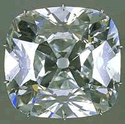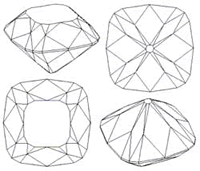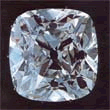 The adventurous history of the Regent is very much like that of several other great diamonds. Greed, murder and remorse play a part in the opening chapter. Political, social, and personal trouble accompanies this diamond to its last resting place. Originally known as the Pitt, this 410-carat diamond was one of the last large diamonds to be found in India. It is said to have been discovered by a slave in the Parteal Mines (also spelled ‘Partial’) on the Kistna River about 1701. The slave stole the enormous diamond rough concealing it in bandages of a self-inflicted leg wound, and fled to the seacoast. There, he divulged his secret to an English sea captain, offering him half the value of the stone in return for safe passage to a free country. But during the voyage to Bombay, temptation overcame this seafaring man and he murdered the slave took the diamond. After selling it to an Indian diamond merchant named Jamchund for about $5000, the captain squandered the proceeds in dissipation and, in a fit of remorse and delirium tremens, hanged himself.
The adventurous history of the Regent is very much like that of several other great diamonds. Greed, murder and remorse play a part in the opening chapter. Political, social, and personal trouble accompanies this diamond to its last resting place. Originally known as the Pitt, this 410-carat diamond was one of the last large diamonds to be found in India. It is said to have been discovered by a slave in the Parteal Mines (also spelled ‘Partial’) on the Kistna River about 1701. The slave stole the enormous diamond rough concealing it in bandages of a self-inflicted leg wound, and fled to the seacoast. There, he divulged his secret to an English sea captain, offering him half the value of the stone in return for safe passage to a free country. But during the voyage to Bombay, temptation overcame this seafaring man and he murdered the slave took the diamond. After selling it to an Indian diamond merchant named Jamchund for about $5000, the captain squandered the proceeds in dissipation and, in a fit of remorse and delirium tremens, hanged himself.
In 1702, Jamchund sold the diamond for about $100,000 to Governor Thomas Pitt of Ft. George, Madras, who was the grandfather of William Pitt of American Revolutionary fame. Known to historians as the “Elder Pitt,” William was the British Prime Minister for whom Pittsburgh, Pennsylvania, was named. He sent it to England and had it fashioned into a 140.50 carat cushion-shaped brilliant cut, measuring approximately 32mm × 34mm × 25mm. The cutting took two years and cost about $25,000, but a number of smaller diamonds brought more than $35,000; some of these were rose-cut diamond that were sold to Peter the Great of Russia. The principal diamond, which has but one very small imperfection, is today considered one of the finest and most brilliant of the known large diamonds.
 In 1717, the diamond was sold to Philip II, Duke of Orleans, then Regent of France, for about $650,000; since that time, it has been known as the Regent Diamond. It was set in the crown of Crown of Louis XV and worn at his coronation in February, 1723. Removed from the crown, it was worn by Queen Marie Leczinska in her hair. Two generations later, when the French Crown Jewels were adorned the Royal Family in many different kinds of personal ornaments; Marie Antoinette used the Regent to adorn a large black-velvet hat.
In 1717, the diamond was sold to Philip II, Duke of Orleans, then Regent of France, for about $650,000; since that time, it has been known as the Regent Diamond. It was set in the crown of Crown of Louis XV and worn at his coronation in February, 1723. Removed from the crown, it was worn by Queen Marie Leczinska in her hair. Two generations later, when the French Crown Jewels were adorned the Royal Family in many different kinds of personal ornaments; Marie Antoinette used the Regent to adorn a large black-velvet hat.
 The coveted diamond disappeared, together with the equally famous Sancy and French Blue (from which the Hope was cut), when the Garde Meuble (Royal Treasury) was robbed of its fabulous jewels in 1792, during the early part of the Revolution. Some of the gems were soon recovered, but the Regent could not at first be traced. After fifteen months, however, the diamond was found, having been secreted in a hole under the timberwork of a Paris garret.
The coveted diamond disappeared, together with the equally famous Sancy and French Blue (from which the Hope was cut), when the Garde Meuble (Royal Treasury) was robbed of its fabulous jewels in 1792, during the early part of the Revolution. Some of the gems were soon recovered, but the Regent could not at first be traced. After fifteen months, however, the diamond was found, having been secreted in a hole under the timberwork of a Paris garret.
In 1797, the great diamond was pledged for money that helped Napoleon in his ride to power. He had in mounted in the hilt of his sword that he carried at his coronation in 1804. When Napoleon went into exile in Elba in 1814, Marie Louisa, his second wife, carried the Regent to the Chateau of Blois. Later, however, her father, Emperor Francis I of Austria, returned it to France and it again became part of the French Crown Jewels.
In 1825, Charles X wore the Regent at his coronation; it remained in the Royal Crown until the time of Napoleon III. Then, a place was made for the diamond in a Greek diadem designed for Empress Eugenie.
Many of the French Crown Jewels were sold at auction in 1887, but the Regent was reserved from the sale and exhibited at the Louvre, among the national treasures. In 1940, when the Germans invaded Paris, it was sent to the chateau country, this time to Chambord, where it was secreted behind a stone panel. After the War, it was returned to Paris and put on display in the Apollon Gallery of the Louvre Museum. It was one of the features of the Ten Centuries of French Jewelry exhibition at the Museum in 1962. An alternate name sometimes used is the Millionaire Diamond.
Diamond Price Calculator
Shape: Round Princess Radiant Cushion Marquise Asscher Pear Emerald Oval Heart
Color: D E F G H I J K L M
Clarity: IF VVS1 VVS2 VS1 VS2 SI1 SI2 SI3 I1 I2 I3
Weight:
Estimated prices for loose diamonds with carat weights 0.40 to 5.99
Click here for BBB Business Review
